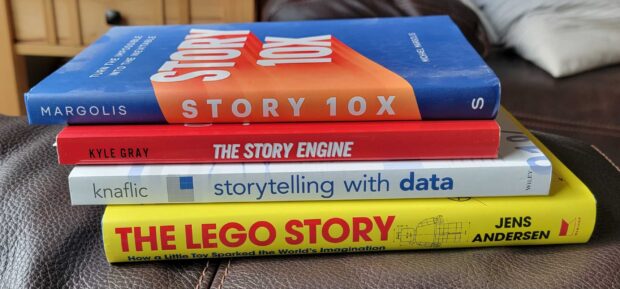Storytelling has been around a long time. From cave drawings, oral histories, and ancient texts to newspapers, television, and social media. It’s relevant in so many ways because the context works in our lives, in business, in community, and more. It’s been around for so long in various forms because it’s effective – because people identify with it and understand the context.
Just the other day my wife shared a book recommendation: Weekend Language: Presenting with More Stories and Less PowerPoint. And there is a LOT of storytelling chatter out there in a variety of contexts: in business, for startups, when talking about communication essentials, and more. For books alone, see the headline image above for just a few examples I pulled off my shelf.
When putting together new presentations and slide decks, we often gather a bunch of facts and info on the list of what we want to cover. But then we step back to look at how we can tell a story with all the information. We want the content to tell a story because the information makes more sense in a context (one or more). It must include context to be relevant. It needs a person, a subject, for folks to relate to how and why the information and data is relevant to them. Don’t just tell us about a new feature. Tell us who will find that new thing valuable and why it’s important to our organization. Presentation content sticks better when attendees understand what good comes from using these new nuggets of knowledge and what risks they take on by ignoring the info.
Storytelling examples in community
There are all sorts of ways that storytelling shows up in our businesses and communities. Here are a few that stand out for me when I think about contexts I often encounter:
Internal organizational example sharing. These often occur at internal user group, lunch and learn sessions, and the like. The context here is easy because it’s folks at the same company typically using similar tools and software. They’re giving a quick 10-minute ‘ish blurb on something they’ve done, built, used, or what have you and why it was successful for them. In that context there are often others that can identify with that success and extend the solution for their own department or group. It’s an easy win, an easy way to multiply ROI, and boosts morale within the org when folks see the value others bring to the table. When I’ve seen and done it myself, it usually generates excitement when folks see an example and immediately want to use it on their team. Great stuff.
The other example I see in the conference event setting is case studies. These are very often some of the most popular and well-attended sessions. It’s commonly the story of how one organization configured, used, and/or built solutions with a particular set of tools. They tell the story of who identified the problem, methods they tried, tools and what they did to skill up to use them, maybe some stumbles along the way, and then what they finally built or used and why it was a success for them. They tell it in a way that other orgs can relate, in ways other teams can understand how to extend their success to deliver success for others. What a wonderful way to build communities between organizations as well.
Startups and skills
Storytelling is rampant throughout the startup world. There are personalities, apps and services, books, and more all talking about it or pitching ways they can help you be a better storyteller. Again, it makes sense. Pitching products is often telling stories about common problems folks face and showing how their product addresses those challenges. Telling those stories effectively is critical.
Not everyone has the innate skills to tell stories well. Sometimes it seems like a natural skill that someone has. Sometimes it’s a learned skill. For a while, we saw a rush of “evangelist” roles within the technical community. These were folks that had storytelling skills and were advocating for specific tools and approaches to business issues. While that role title seems to have waned, we’re now seeing roles like “Digital Storyteller”. Organizations have identified the need for storytelling, in a variety of contexts, that show the need for skills creating content and conveying stories.
As if we needed another reminder of the importance of soft skills in addition to all the tech skills we’re required to have these days. 🙂
The Flip Side
Like anything else, there’s the not-great side of storytelling as well. There are plenty of folks that haven’t honed their skills quite yet. Some are still learning and will improve with time and effort. Then there are folks that took a wrong turn somewhere along the path and need to make corrections. There are the buzzword-bingo slinging folks that think they’re offering value but are really just talking, often with little substance. We run across them everywhere. In many cases folks can see right through it, but they continue to take up bandwidth all the same. Be nice, give them the constructive feedback when you can. The battle continues…
